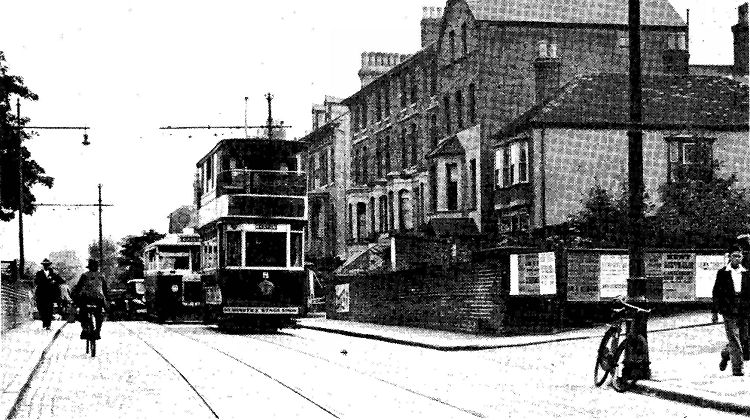Page Updated:- Sunday, 07 March, 2021. |
|||||
 Published in the South Kent Gazette, 29 October, 1980. A PERAMBULATION OF THE TOWN, PORT AND FORTRESS. PART 126.
WESLEY HALL Near the bottom of Folkestone Road and its junction with Priory Road was built in 1910 the Wesley Methodist Church, long known as Wesley Hall, and adjoining it was the minister’s manse on the site of what is now the church hall. By 1910 there was already in Dover a number of Primitive and Wesleyan Methodist churches but for over 30 years there was a movement, called The Wesleyan Methodist Extension Scheme, engaged in planning and raising funds to build a new central church hall with part of the site reserved for building a larger church. The •total cost of the project, including the construction of a manse, was about £5,400. The nucleus of a fund was formed as early as 1902. On 8th June, 1910 the stone-laying ceremony took place, followed by another for the children of the church, on 5th October. No time was lost in construction and Wesley Hall opened its doors for the first time on 16th November, 1910. The opening service was conducted by the Rev J. Hugh Morgan, of Folkestone, President of the Kent District. This was followed by a celebration tea meeting in Salem Baptist School (Hall and later by a public meeting to celebrate the achievement of building a new church. The proceedings opened with a prayer by the Rev P. P. Basden, Congregational minister at Dover. The Rev W. Holyoak, pastor of Salem Baptist Church, was also among the speakers. First pastor at Wesley Hall was the Rev S. Hankin Hardy. The construction of the Wesley Hall, by Messrs Hayward and Paramor, was seen as the first step in a grand scheme of extension by the Wesleyan Methodists, the next step proposed being the construction of a much larger church on a site adjacent occupied by a property known as Swiss Cottage.
TWICE DESTROYED Little did the Wesleyans realise during those early celebrations that the church 'was soon to be destroyed by a 200 lb bomb dropped by a raiding Gotha aircraft during the First World War. The date was 24th September 1917. The bomb struck the rear gable of the church, blew the roof off and masonry came tumbling down. The adjoining manse was also badly damaged. Fortunately a planned Band of Hope meeting did not take place and those who were in the manse heeded the air-raid warning and took refuge in the cellar with the result that none of the congregation was killed. Within twelve days arrangements had been made to hold services in the small hall in Saxon Street and work began to raise funds to rebuild the church. By January 1920 Wesley Hall was functioning again and Lord Duncannon, MP for Dover, officially re-opened the church on 3rd March. During the period of service of the Rev Douglas A. Griffiths (1925-28) additional temporary buildings were erected close to the church for the growing youth work of the church and in 1927 a gallery was brought into use. There was also a proposal that Wesley Hall should be adapted as a Central Hall for the East Kent Coalfields, at a cost of £26,000, but it was decided the scheme was too ambitious at that time. Just before (the Second World War, when the church was again badly damaged by enemy action, Wesley Hall received its first pews which were transferred from Buckland Wesleyan Church when that was closed. Prior to 1938 there were individual chairs. During the Hitler war services, due to the blackout, were held in the Saxon Street hall in the afternoons. In 1941 the annexe was destroyed by enemy action and less than twelve months later the church itself was hit and, for the second time in its history, became a mass of rubble and broken timbers. Undaunted plans were again made to rebuild and the re-opening service took place on 5th April, 1949. The adjoining hall, replacing the annexe, was opened on 28th February 1953. On the south side of St. Martin’s Hill the ages of the tenements varied. The Red Cow on the corner of Folkestone Road and Priory Place, now demolished, was originally an old inn standing on the margin of the Priory Fields, when cows grazed there. The inn was later rebuilt. Adjoining it there used to be its own livery stables and garage which were later taken over by Lewis Brothers, the motor engineers and taxi proprietors. Next door stood the Griffin Inn which flourished as a beerhouse from a period soon after Christ Church was built.

Wesley Methodist Church in Folkestone Road shattered and roofless after being struck by a 200 lb bomb which was dropped on the rear gable of the building by a German aircraft during the First World War. A remarkable feature is that the blast left the neat rows of chairs almost undisturbed.

Between the First and Second World Wars a Maxton tram car and a Folkestone-bound single-decker bus on Priory Station bridge make their way up Folkestone Road. Posters on the railway bridge advertise a Kent v Australia cricket match at Canterbury and a Wimbledon tennis tournament The Dover Corporation tramcar advertises a 40 Minutes’ Stage Show at the old Hippodrome Theatre in Snargate Street.
|
|||||
|
If anyone should have any a better picture than any on this page, or think I should add one they have, please email me at the following address:-
|
|||||
| LAST PAGE |
|
MENU PAGE |
|
NEXT PAGE | |